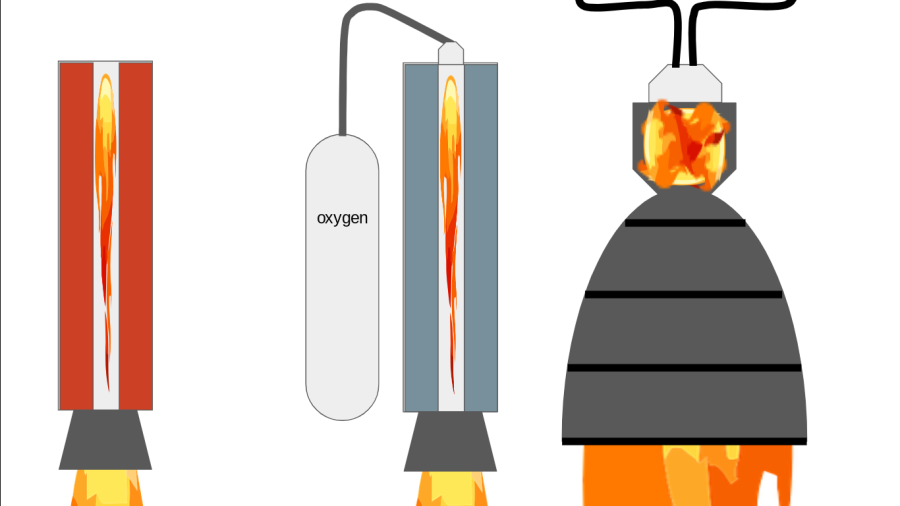Everything You Need to Know About Rocket Engines.
December 6, 2022
Many of you are aware of what a rocket is, and what they do. But do you know how they work? I’m guessing not. But, hopefully, after reading this, you know everything you need to know about the guts inside rockets.
First, we will discuss the simplest kind of rocket engine, which is the model rocket engine. The rockets that are propelled by these engines are little more than a parachute, jammed into an aerodynamic casing with fins, with the engine rammed up the bottom. If you ignite the engine, you see a trail of smoke and fire, and the rocket flies upward.
All rockets work with Newton’s 3rd law of motion, where an action results in an equal and opposite reaction. The rocket ejects hot gases backward, which in turn pushes the rocket upwards. These combustion rocket engines use combustion to generate high-pressure gases, which are turned into high-speed gases with a nozzle, which accelerates the gas past the speed of sound.
Most model rockets use black powder as a propellant, but NASA uses a cocktail of ammonium perchlorate, aluminum powder, and iron oxide. To make the best combustion, you need fuel and an oxidizer. This makes it burn more energetically, and that makes it easier to turn into high-speed gases.
The second (and least well-known) kind of rocket engine is the hybrid rocket engine. These are a combination of solid-fuel rockets and liquid-fuel rockets. They are an unoxidized solid fuel in a tube, with an oxidizer injector at the top. This blows the oxidizer past the solid fuel, allowing it to burn better. The main advantage to these as opposed to other rocket engines is that they can be throttled, and possibly even shut off, unlike solid rocket engines, and they are much simpler than liquid fuel engines.
The third kind of rocket engine is a liquid fuel engine, which is slightly more complex. They burn 2 liquids to generate pressure instead of a solid mixture. They have 4 main parts: the plumbing, the injector, the combustion chamber, and the bell. The plumbing is what transports the fuel from the tanks to the engine, by way of pumps or pressure. There are several methods to rotate the pumps, such as gas generators, pre-burners, or electric motors.
The injector is one of the most crucial parts of the engine because it sprays the fuel into the chamber. It needs to A) mix the fuel and oxidizer, B) aerosolize the mixture, and C) not let the fuel burn back to the fuel tanks and blow them up. The most commonly used design is the impinging injector, where multiple streams of fluid are sprayed together, which mixes them together and aerosolizes them, so they burn better.
The combustion chamber is the heart of the engine because that’s where the combustion takes place and generates the pressure. It is usually a cylinder with the injector at the top, but sometimes the fuel is fed in through the sides. There, it is ignited, and extreme pressures are generated, which forces a lot of hot gases out of the nozzle, which is what we will talk about next.
There are 2 main types of rocket nozzles, which are the de Laval and the aerospike. The de Laval nozzle is the classic rocket nozzle, with that huge bell on the bottom. These are very common and relatively light, but they have one big issue: they only perform best in one pressure, in others they are less efficient because the bell is designed to expand the gases to fit the current atmospheric pressure. But the higher you go, the pressure decreases, which makes the nozzles less efficient, so your rocket will not be as powerful.
The other type of nozzle is the aerospike. They don’t have the same pressure issues as the de Laval nozzle, but the large spike makes it heavy and a pain in the butt to keep from overheating. It often has a donut-shaped combustion chamber, so the gases can head straight out the nozzle. In the lower atmosphere (higher pressure) the exhaust gases are pressed against the spike, but in the higher atmosphere (lower pressure) the gases are free to expand because there is no bell that constricts them.
Overall, I hope this article taught you everything you need to know about rocket engines, whether you’re a maker, bored, or just a fellow space nerd. I hope you enjoyed this article, and I will see you next time!

Aname • Dec 9, 2022 at 1:05 pm
Great Job! I like your work and how simple you made it!